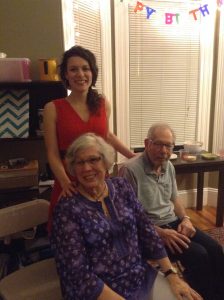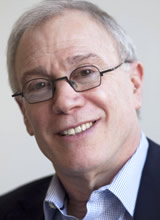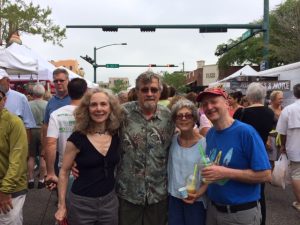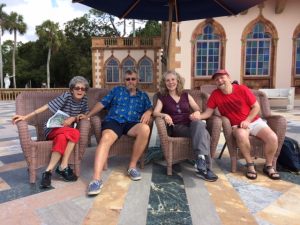Episode Description
This episode features Laurie Sheridan, who speaks candidly with warmth and humor as she describes what it’s like caring 24/7 for her husband, Ira, who has Parkinson’s Disease. Rick Surpin has a cameo in this episode. Rick is the Founder of Cooperative Home Care Associates, a worker-owned home care agency in New York City. At the end of the episode, we hear a “teaser” from Ai-jen Poo who is featured, along with Sarita Gupta, in Episode 2. Ai-jen directs the National Domestic Workers Alliance, and Ai-jen and Sarita Co-Direct Caring Across Generations.
Guest Bio: Laurie Sheridan

After growing up in New Jersey and Boston-area suburbs, I graduated from Wellesley College in 1966 with a BA in Philosophy. After spending several years pursuing a Ph.D. in Philosophy at Yale and Boston Universities, I dropped out of school to become a more or less full-time activist in the anti-Vietnam War, civil rights and women’s movements Along the way, I married my college boyfriend, had two sons, now 47 and 50, and divorced my husband in the early ‘70’s. In the late ‘70’s, I also taught graduate courses at the former “Cambridge-Goddard Graduate School for Social Change,” where I taught Women’s Studies and union organizing, and where I met my current husband, Ira Gerstein. As a single mom with two small children, I supported us through jobs as a union organizer and shop floor activist, and in that role became interested in a number of areas and decided to pursue as a career, especially “women’s issues” like child care, family leave, and work-family balance; workplace health and safety; and finally, labor education and adult education, on which I have focused in recent years.
I worked in my 20’s and 30’s helping organize workers into unions while working in printing, health care and manufacturing, and then spent about 10 years as a skilled machinist and union leader at the giant General Electric manufacturing plant north of Boston, where I led the union women’s committee, was a plantwide shop steward, and helped the union develop training, education, child care, and health and safety programs for 8,000 unionized workers in the plants. I left GE and IUE in 1987, after I had a third child (my daughter Bethany, now 33). I went to work at MassCOSH, the Massachusetts Coalition for Occupational Safety and Health, a union-based education and advocacy non-profit. Since then, I worked in adult education, workforce development and labor education for over 25 years, as Executive Director of The Childcare Project and the Boston Workforce Development Coalition. Along the way, I also worked as a community organizer at Parents United for Child Care and directed programs at the Child Care Resource Center in Cambridge. From 2004 until my retirement in 2014, I was the Workforce Development Coordinator at World Education and the College and Career Readiness Coordinator for SABES, the System for Adult Basic Education Support, at the Adult Literacy Resource Institute at U. Mass. Boston. In this role, I taught staff of adult education programs how to incorporate work-related materials, curricula and supports into their programming and instruction.
I retired in late 2014, and since then have spent more and more time on providing care for my husband, who has had Parkinson’s Disease for about 15 years and is now totally disabled. It is definitely the hardest job I have ever had. It requires all my time, energy, patience, and stamina, and I too am getting older. I also collaborated with my younger sister in providing care for our mother who died last year at 104. Our recent lives have been pretty parallel. And after having spent years working with training and career ladder advancement programs with nursing home assistants and home health aides, I am now applying everything I learned from those experiences in my own daily life, and especially learning new and valuable skills and personal qualities from my husband’s aides, who now help care for him every day and some nights. I am also lucky to have worked for many years with child care workers in another caring profession, since every day I am reminded of the similarities between adult caregiving and child care, even though my husband weighs 165 pounds, has two PH.D.’s and is of course an adult. But many of his needs, and the demands of providing care for him, are astonishingly similar. My life has now come full circle in many ways, in my own older years.
Guest Bio: Rick Surpin
 Rick Surpin is the founder and President of Independence Care System (ICS) a 20 year old nonprofit organization in New York City which supports adults with physical disabilities to live at home. Rick is also the founder of Cooperative Home Care Associates (CHCA), a worker-owned home care agency which served as the prototype for the “Better Jobs, Better Care” model of care. He served as the CEO for 16 years and as Chairperson of the Board for 33 years. He also was the founding Chairperson of the Board of PHI, a national nonprofit organization which promotes and further develops the “Better Jobs, Better Care” model, and served in that role for 27 years.
Rick Surpin is the founder and President of Independence Care System (ICS) a 20 year old nonprofit organization in New York City which supports adults with physical disabilities to live at home. Rick is also the founder of Cooperative Home Care Associates (CHCA), a worker-owned home care agency which served as the prototype for the “Better Jobs, Better Care” model of care. He served as the CEO for 16 years and as Chairperson of the Board for 33 years. He also was the founding Chairperson of the Board of PHI, a national nonprofit organization which promotes and further develops the “Better Jobs, Better Care” model, and served in that role for 27 years.
Blog
A personal encounter with Parkinson’s Disease that led me to Laurie Sheridan
When I decided to create a podcast on caregiving, a number of friends suggested people I should interview or stories I should capture. As I reflect on why I interviewed Laurie Sheridan, it was, in part, because I heard that she was caring 24/7 for her husband, Ira, who has Parkinson’s Disease. I had known Laurie for many years through professional and personal connections, but we had lost touch. But my draw to Laurie was also influenced by my own experience as a friend to someone who ultimately died of the disease. Here is their story.

I first met my friend, Carrol, at the luscious, small farm in Vermont where she lived with her husband, Jon, and their two then-teenage sons. Carol was a clinical psychologist, and Jon did international development work. I was introduced to the two of them by Peter, this British guy I was dating at the time. He had lived on the farm with them for a couple of years, but had moved into his own little cottage, as he called it, where I would visit from Boston. Peter, that “guy I was dating”, and I have now been together for over thirty years.
I loved hanging out with Carrol and Jon. They were opinionated, smart and curious, always sharing insightful, funny stories of some misadventure. And their boys, both now theater artists, had absorbed the gift of storytelling, as they regaled us with tales of characters in their small town. Over the years, our relationship with Carrol and Jon and “the kids” grew.
Jon had been in the Peace Corps before he met Carrol. Fifteen years later, when the kids were grown, he and Carrol moved to Arusha, Tanzania for a couple of years. Carrol learned to speak Swahili, and she started counseling nationals and expatriates. She also worked as a consultant, trainer and grant maker for foundations and nonprofit organizations. Eventually, after a few years, the two of them returned to the states and resumed their lives in Vermont.
About 10 years ago, Carrol started having a lot of pain, accompanied by crippling anxiety. She saw western doctors and eastern practitioners, but no one could figure out what was going on. Her symptoms worsened, but she and Jon had decided to travel back with Jon to Tanzania, in the hopes of making it a long-term stay. When she arrived, her symptoms were so extreme that she had to be rushed back home. Carrol’s symptoms grew worse, her body alternately freezing up as if she were paralyzed, and then moving erratically and uncontrollably. When we took walks down their country road, she would careen off the path, but still refused a helping hand. Jon had slipped into becoming her 24/7 caregiver, but Carrol wanted to remain independent. That was tough. But Jon was devoted to her and stuck with her until the end.

I loved Carrol, and whenever we were all together, I spent a lot of one-on-one time with her. Her movements were out-of-control much of the time, and strangers would stare at her when we were out in public. But we would ignore them and continue our banter. That was one thing I loved about Carrol. She remained funny and kind, despite everything.
Eventually, Carrol was diagnosed with having “Atypical Parkinism”. Her symptoms didn’t align perfectly with the disease, but her doctors felt they were “Parkinson-like”. They started her on Parkinson’s medication to see if that might make a difference. And for a while it did. But over the next few years, Carrol’s health got worse. Winters were particularly challenging. So Jon moved them down to Sarasota, Florida, where there was a program called Parkinson’s Place, designed exclusively to meet the physical, social and emotional needs of people living with Parkinson’s. The program also provided support for their caregivers. Living in sunny Florida was decidedly a lot easier on Carrol’s health. Jon was consumed with being Carrol’s 24/7 caregiver. And their days were spent either at Parkinson’s Place or just hanging out, exploring Sarasota.
Peter and I visited Carrol and Jon during their winters in Sarasota, and in the summer, when they returned to Vermont. There was no question; Carrol was steadily declining. She suffered with terrible pain, and eventually with dementia and paranoia. The two of them had always loved to travel, but with Carrol mostly home-bound, Jon began to paint portraits, and this became his passion. Parkinson’s is a degenerative disease and can be brutal. Jon was learning that first-hand. After five years of living with the disease, Carrol died. At a memorial service for her, over a hundred friends gathered to share stories about Carrol’s humor, warmth and intelligence, and to recognize what a long haul it had been for her and for Jon, as well as for their two sons.
This experience of being with Carrol and Jon, and watching her disease take over their lives, was what drew me to talk with Laurie Sheridan. I heard through the grapevine that her husband, Ira, had Parkinson’s, and I wanted to reconnect with her to see how she was doing. Laurie never expected that she’d be spending her retirement years caring for Ira. And I hadn’t planned to interview Laurie for The Shape of Care. But I was deeply moved by her story, and by how Laurie talked about the experience of being a full-time caregiver.
In Episode 1, Laurie speaks with humor and honesty about how she has coped with Ira’s disease, and how it has taken over her life. Laurie is a storyteller, and I feel grateful that she was so open about her experience as a caregiver for Ira. If hearing her story brings up thoughts or questions, please email us at contact@theshapeofcare.org; or call us and leave a message at 617-600-8790.
Resources
Please note that this list isn’t comprehensive. It includes some programs for people with Parkinson’s, as well as dance and yoga programs.
Parkinson’s Disease programs
There are Parkinson’s programs throughout the country. Here are some:
- In Boston: Beth Israel Deaconess Program
- In Sarasota: Sarasota Parkinson Place
- In Rochester: Community-based Parkinson’s programs
- Dance and Parkinson’s Disease
- Yoga and Parkinson’s Disease
“Best Resources for Parkinson’s Disease Awareness” From Senior Living Blog
More Resources for Parkinson’s Awareness
- National Parkinson Foundation (NPF): Provides support and care services for people with PD. The NPF has given millions of dollars to research projects focusing on innovations in treatment and the development of a potential cure.
- Michael J. Fox Foundation (MJFF): Strives to make progress toward new and improved treatments that can slow or stop the progression of Parkinson’s, better address symptoms of the disease and avoid the side effects of current medications.
- Parkinson’s Disease Foundation (PDF): Supports people living with PD through the funding of scientific research into the disease, educational programs and services, and public advocacy initiatives.
- Parkinson’s Action Network (PAN): Partners with organizations and a grassroots network to educate the public and legislators on policies related to research and quality of life for people living with Parkinson’s.
- American Parkinson Disease Association (APDA): Focuses on research, public services, education and raising PD awareness, with the goal of finding a cure and easing the burden of having the disease.
- The APDA National Young Onset Center: Through education and personalized support services, addresses the unique needs of young people with Parkinson’s, their families and health care teams.
- National Institute of Neurological Diseases and Stroke (NINDS): Details the signs and symptoms of PD, lists current and upcoming research studies, and calls for volunteers for clinical trials.
- Parkinson Study Group (PSG): A non-profit group of physicians and health care providers dedicated to researching and advancing knowledge Parkinson’s disease, treatment and related disorders.
- Parkinson’s Disease Research, Education and Clinical Centers (PADRECC): A division of the Department of Veterans Affairs, PADRECC serves the approximately 80,000 veterans with PD through research, state-of-the-art clinical care, national outreach and advocacy.
- Parkinson’s Disease and Caregiving (Family Caregiver Alliance): Details Parkinson’s stages, symptoms and risks and how caregivers can manage treatments and find support.
- The Parkinson’s Institute and Clinical Center (PI): Located in Sunnyvale, California, the PI is the only independent, non-profit organization that provides basic and clinical research, clinical trials and patient care for PD and related neurological movement disorders in a single location.
- Parkinson’s Disease in the Elderly: Explains the symptoms, diagnosis and common treatment options for seniors with Parkinson’s.
- Parkinson’s Disease: In the Shadow of Alzheimer’s: Describes Parkinson’s symptoms and proinformation on how the BRAIN initiative will help fight neurodegenerative brain diseases like Parkinson’s and Alzheimer’s.
- Can Vitamin D Reduce the Risks for Parkinson’s Disease?: Discusses the latest research and impact of vitamin D levels in the risk and treatment of PD.
- Study Reveals New Targets for Parkinson’s Disease: Discusses some of the latest scientific approaches on identifying genes that may contribute to the disease.
- BRAIN Initiative: Details the Brain Research through Advancing Innovative Technologies (BRAIN) initiative and how it will help accelerate research and advancements in the field of neurologic and psychiatric disorders.
- Parkinson’s Disease: Quickly Identifying Patients at Risk of Dementia: Indicates a link between Parkinson’s and the acceleration of brain deterioration related to dementia.
- Coping Tips for Caregivers of Those With Parkinson’s Disease: Tells the challenges caregivers of individuals with PD and how they can cope as their loved one’s condition progresses.
- Parkinson’s Disease Progression: Describes the stages of the disease and the changes a person can expect as the disease progresses.
- Parkinson’s Unity Walk (PUW): A 1.4 mile walk that takes place annually in New York City to raise research funds and awareness for Parkinson’s. In 2013, the PUW raised over $1,700,000 for Parkinson’s research.